
What is Personal Protective Equipment?
Personal protective wear, known in the United States as Personal Protective Equipment (PPE), protects workers from injury or illness resulting from contact with physical, mechanical, chemical, electrical, radiological, and other workplace hazards. PPE includes face shields, safety glasses, hard hats (helmets), gloves, earplugs, respirators, protective clothing, safety shoes, and more.
Employer Personal Protective Equipment Requirements
OSHA maintains requirements for PPE in various industries, including shipyards (29 CFR 1915), marine terminals (29 CFR 1917), longshore work (29 CFR 1918), fire protection (29 CFR 1910.156) and for general industry (various sections in 29 CFR 1910).
OSHA's PPE requirements generally direct employers to conduct a hazard assessment of their workplaces. Based on this assessment, employers must provide PPE that protects against any hazards that cannot be eliminated or controlled using engineering or administrative controls. Employers must:
- Require the use of personal protective wear as determined by the hazard assessment
- Provide the necessary and appropriate protective wear
- Train workers in the use and maintenance of the personal protective wear
- Require workers to maintain it in a sanitary and reliable condition
Personal Protective Equipment - The Last Line Of Defense
PPE is essential for protecting workers from harm, but it is also the last line of defense. The following should be done before personal protective wear is used:
- Engineering controls: physically changing or redesigning a machine, using a different machine, or redesigning the work environment.
- Work practices: changing how the work is done, for example by providing training in new ways to get the job done that reduces exposure to workplace hazards.
- Administrative controls: changing how workers do their jobs, or changing when work is done such as scheduling work and rotating workers to reduce exposures.
Train Workers on Their Personal Protective Equipment
OSHA requires employers to train workers who will use PPE. Training must include the following:
- How to properly use the personal protective wear
- Know when personal protective wear is necessary
- Know what kind of protective equipment is necessary
- Understand the limitations of the protective equipment
- How to put on, adjust, wear, and take off personal protective wear
- How to properly clean and maintain the equipment
Types of Personal Protective Equipment
PPE comes in many forms. Here are a few ways it keeps workers safe on the job.
Protection from Head Injuries
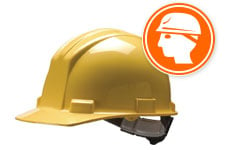
Hard hats (helmets) protects against head impact, penetration injuries, and electrical injuries resulting from contact with electrical conductors. A hard hat provides protection from falling or flying objects such as tools; walking into fixed objects; standing up and hitting a fixed object; and from potentially hot objects.
Other forms of head protection include hats and hair nets. These may prevent long hair from getting caught in rollers, belts, gears, chains, and other moving machine parts.
Foot and Leg Protection
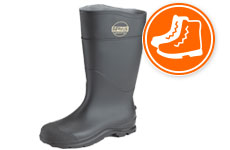
Safety shoes (such as steel-toed shoes) are commonly used in the workplace to protect against crushing injuries caused by falling or rolling objects, sharp objects, wet and slippery surfaces, molten metals, hot surfaces, and electrical hazards.
Shoes with no-slip soles provide slip protection. Foot guards protect feet from spills and falling objects. Leggings, such as leather or aluminized rayon, help protect against high temperatures, cuts and impacts.
Hand Protection
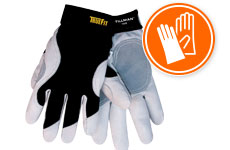
Hand protection includes various types of gloves and gauntlets. Hands need protection from abrasion, cuts, punctures, chemicals, high and low temperatures and other hazards. Selecting the right hand protection is important.
Different types of glove material provide protection against different types of hazards.
Body Protection

PPE must occasionally shield most or all of the body from chemicals, heat and radiation, hot metals, fire, scalding liquids, body fluids, and other hazardous materials or waste.
Protective wear for the body includes aprons, coats and full-body protection. Materials used for protective clothing include fire-retardant wool, fire-retardant cotton, rubber, leather, synthetics and plastic.
Protective wear for the body includes aprons, coats and full-body protection. Materials used for protective clothing include fire-retardant wool, fire-retardant cotton, rubber, leather, synthetics and plastic.
Eye and Face Protection
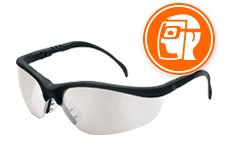
Your eyes and face need to be protected from flying objects such as flying fragments, large chips, dust, sand, grit, mists, splashes from molten metals and hot sparks. Eye and face protection may also provide protection from optical radiation and glare.
Options for eye and face protection include glasses and goggles, special helmets, helmets with shields, eyeglasses with side shields, and face shields.
Hearing Protection
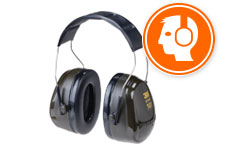
Earplugs and earmuffs are the most common type of ear protection. They protect against high noise levels, which can cause irreversible hearing loss, as well as physical and psychological stress.
Earplugs are most often made from foam, waxed cotton, or fiberglass wool. They are typically self-forming and usually fit well. When molded or preformed earplugs are used, they should be individually fitted by a professional.
Ear protection, including earplugs should be cleaned or replaced regularly.
Respiratory Protection
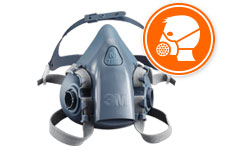
When engineering controls are not feasible, appropriate respirators must be used to protect people from the adverse health effects caused by breathing air contaminated with harmful fumes, dusts, fogs, mists, smoke, gases, sprays, or vapors.
Respirators either cover the nose and mouth, the entire face, or the entire head. A respirator must fit properly to be effective.
Respirators must be approved by the National Institute for Occupational Safety and Health (NIOSH), and employers must provide medical evaluation and training before use.
Visual Communication and Personal Protective Equipment
Safety signs are a critical component of any workplace's safety program. Proper signage can warn employees of hazards, identify areas where PPE is required, and communicate the types of PPE employees must wear. Create your own safety signage with DuraLabel industrial label and sign printers by Duralabel.
Don't miss your opportunity to download our free Personal Protective Equipment (PPE) Reference Chart to post around your facility to educate staff about the importance of PPE. Get your copy below!
Related Resources

1910 135 Head Protection
OSHA 1910.135 establishes workplace risk assessments for a head injury as the employer's responsibility to ...
Read
Three Essential Tips to Prevent Workplace Head Injuries
Brain Injury Awareness Month Every year, the Brain Injury Association, the nation’s oldest and largest brain ...
Read
1910 133 Eye And Face Protection
The Center for Disease Control and Prevention reports that each day 2,000 workers have a work-related eye ...
Read.png)





